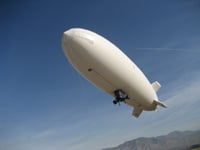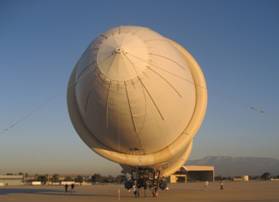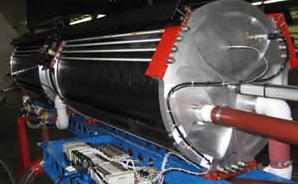Original URL: https://www.theregister.com/2008/09/22/aeroscraft_pasternak_airship_design_darpa_pork/
Miracle airship tech sustained by DARPA pork trickle
Designer claims to have cracked century-old snag
Posted in Science, 22nd September 2008 06:02 GMT
A Ukrainian airship visionary based in California has won further US military funding to develop his miraculous "Aeroscraft" sky-leviathan design. However, some question marks remain over the craft's unique - almost miraculous - buoyancy-control technology.
Aeros Aeronautical Systems Corp announced last week that it had been awarded a contract to demonstrate its lightweight rigid aerostructure technology. The money was awarded by DARPA*, the famous Pentagon wackboffinry bureau known for its defiant reliance on the appliance of science to all military problems.
The super-lightweight rigid structure, which Aeros founder Igor Pasternak will now pull out of his hat, will need to be remarkable stuff. The proposed Aeroscraft rigid airship would be strong and stiff enough to handle heavy loads, and to transmit significant forces from attached stub wings, fins, and vectored-thrust props. Pasternak sees the structure as one of the two special sauces which will make his sky-ship project genuinely capable and airworthy, unlike so many others.
But the super-structure kit will be far from the most startling thing about the Aeroscraft, should it ever get built. Pasternak's other proprietary trick - which he calls Control Of Static Heaviness, or COSH - is far more remarkable, and he claims to have cracked that already. If it's true, Pasternak has solved a well-nigh impossible engineering problem that has bedeviled airship designers for almost a century.

A bagbox of hot (or cold) air. And helium. Pic: AAS
The problem is a relatively simple one: that of controlling buoyancy when losing weight. In order to move about, an airship must burn fuel, so becoming lighter. More seriously, in order to operate, it will often need to drop off cargo or passengers. In either case the ship will become more buoyant and tend to ascend more and more powerfully.
This is bad, because pressure decreases as the ship soars upward, causing the lifting-gas cells inside it to expand. It's normal for part of the ship to hold air at surface level, allowing the ship to reach a decent altitude safely, but enough uncontrolled buoyancy will loft the vessel to "pressure height", where expanding gas cells have driven out all the air and fill the ship completely.
At pressure height, automatic valves open and start venting off lifting gas to prevent the ship bursting. It may be possible to regain control and achieve a safe landing in the end - though not always - but a lot of gas will definitely be gone until the ship can be refilled. This will also be true if the pilot vents gas in advance, so as to prevent a dangerous excursion above pressure height. Either case is unacceptable, as nice safe helium costs far too much to be thrown away whenever cargo is dropped off or fuel burned. Nobody has been willing to use cheap but highly-flammable hydrogen since the Hindenburg disaster.
There are various existing solutions to this problem, but all have their disadvantages. If a ship is delivering people and cargo at a properly-equipped mooring mast, it can take on water ballast through a nose connection at the same time, so remaining neutrally buoyant. Fuel burn while airborne can be dealt with by recovering an equal weight of water from engine exhaust using condensers. These systems were used successfully in the US Navy's 1930s helium airships, USS Akron and Macon.
But one of the main selling-points of an airship in today's world is its ability - potentially - to deliver heavy cargoes to places without established mooring masts and water-ballast supplies. That's certainly a major role seen for them by the US military today, so airship designers need to think of ways to do without such luxuries.
One such method does exist. Airship engines can be run on gaseous fuel which weighs the same as air - "blaugas" - which can be kept in cells within the ship. As the blaugas is burned, it gets replaced by air and the ship's buoyancy is unaffected. This system was used successfully aboard the Graf Zeppelin, a hydrogen ship. But when trying to avoid building a huge thin-skinned balloon full of flammable gas - as in a helium vessel - blaugas is something of a retrograde step.
Another method is the use of vertical thrusters to support the load, with the gas envelope handling only the weight of the ship. This was the idea behind the unsuccessful Piasecki Heli-Stat, now being revived by Boeing under the name "SkyHook". But this is no longer a true airship - more of an airship-helicopter combo. It will have to dump its load to stay airborne if it loses vertical thrust, and it won't have the range and fuel economy offered by a fully-buoyant ship.
But why not simply compress the helium into high-pressure storage tanks when it's not needed?

An Aeros test blimp without COSH.
The answer, as given by generations of airship-loving engineers, has been that it just isn't feasible. Even the strongest tanks can only hold so much pressure; given the immense volumes of helium which would need to be crammed away in order to cope with a large cargo being dropped off, the storage tanks required would still be very large - and thus tremendously heavy, as they'd need to be made of very strong stuff. Then, in order to compress the helium in a reasonable amount of time, massive compressors would be necessary - with hefty transmissions to carry power from the ship's engines.
But Igor Pasternak reckons he's cracked this with his mysterious COSH technology - which he says was developed for DARPA and tested successfully this summer aboard a normal non-rigid blimp. According to Pasternak, "this system works by compressing, storing then decompressing helium within the envelope to adjust the vehicle’s buoyancy" (our emphasis).
Looking at Aeros' pic of a COSH-equipped blimp as compared to one without, the difference seems to be a pair of large doughnut-like affairs around the outside. One might speculate that Pasternak is using modern materials to make these contain helium at relatively low pressures - just enough that it becomes significantly more dense, so forfeiting buoyancy to the tune of several times the tanks' own volume and perhaps adding weight to boot if the tanks are strong enough. A toroid shape like the ones pictured is particularly efficient at containing pressure, and could add stiffness to the ship as well. As for the mysterious cylindrical machinery shown by Aeros to illustrate COSH, who knows? But it might perhaps be an efficient compressor/condenser for pushing gas into the toroid tanks. These would, in a rigid ship, be placed within the envelope.

Same blimp, with COSH. External lo-pressure tanks?
However it works, if Pasternak can be believed, he has achieved what such legendary engineers as Hugo Eckener and Frank Piasecki regarded as impossible; and one of the greatest weaknesses of the airship has been solved. A titanic "Aeroscraft" should indeed be able to haul an entire US Army unit with all its supplies - more than 500 tons of load - around the world in days and drop it off in the middle of a desert, without losing any of its valuable helium.
Well, maybe. Specifics on the COSH kit aren't forthcoming, but it seems clear that in fact even Pasternak doesn't think it could compensate on its own for the sudden disembarkation of several hundred tons, as in the "Walrus" military mega-ship once planned by DARPA.
The Walrus, on a long-range mission, would probably have taken off in a very heavy condition - Pasternak describes his Aeroscraft as "a heavier than air design". On departure, the ship would use its engine exhaust to superheat its helium cells, making them expand to fill the whole hull and gaining extra lift. The takeoff would probably be a rolling one, generating still more lift from the craft's wings and body to get airborne.
On arrival, the ship could set down vertically supported only by its props, swiveled to point upward; it would have lost a lot of weight in burned fuel, and wouldn't need forward-motion dynamic lift to stay aloft. Then, chilling systems would cool the helium, shrinking the cells and cutting buoyancy drastically. Air drawn into the ship as a result would also be chilled down, making it heavier and reducing lift still further. The COSH miracle-compressor equipment would also be doing its part.
All this, according to Pasternak, would mean that after a reasonable amount of time the soldiery and all their heavy equipment could safely drive off the ramps without fear of the mighty airship suddenly lurching uncontrollably upwards as they did so. But there would still be no need to vent off expensive helium.

Perhaps a new kind of compressor?
But the return of great airships remains uncertain. The DARPA Walrus was cancelled in 2006, though the agency did hand out some cash to Pasternak to demonstrate his COSH gear. Apart from that, however, Aeros has had to content itself with its established business making and leasing out ordinary nonrigid balloon-type blimps, aerostats etc. - mostly for advertising purposes.
The recent award of more DARPA cash to develop Aeros' super-strong yet super-light rigid structure tech could be taken to mean that some heavy-lift airship diehards are still clinging on at DARPA - but probably not. As Wired magazine points out, the $2m seems to have been budgeted as the result of a Congressional "earmark," by a Californian politician representing Aeros' home territory. The money would seem to have appeared as a matter of porkbarrel politics rather than genuine military enthusiasm.
That's not to say that Pasternak can't do what he says; the Walrus may not have been cancelled because it couldn't, in DARPA's view, be built. Even if it worked exactly as described on the tin, Walrus would have been a bit marginal from a military point of view. With a maximum pressure ceiling of 10,000 feet - probably less in reality - and top speed of only 140 knots, the enormous machine would be an easy target even to lightweight shoulder-fired missiles along its entire flight path.
The Aeroscraft is now being offered in a smaller - though still pretty huge - design, the rather yummy looking ML866 (Flash!). This design has been going through initial FAA acceptance since March. The ML866 can be set up as a nifty flying office or conference suite; a sort of aerial bateau-mouche restaurant/observation cruiser; or - of course - a private luxury sky yacht. Alternatively Aeros will do you a bigger commercial cargo job, though not of the size that DARPA wanted - "up to 60 tons" of payload are on offer.
Let's hope that some rather less boring billionaire, tired of dull water megayachts, space tourism etc., comes forward and gives Pasternak a chance to really show what he can do. ®
*The Defence Advanced Research Projects Agency